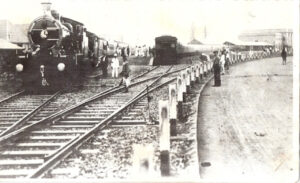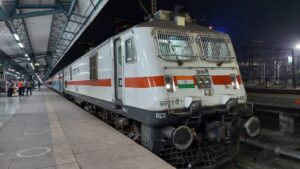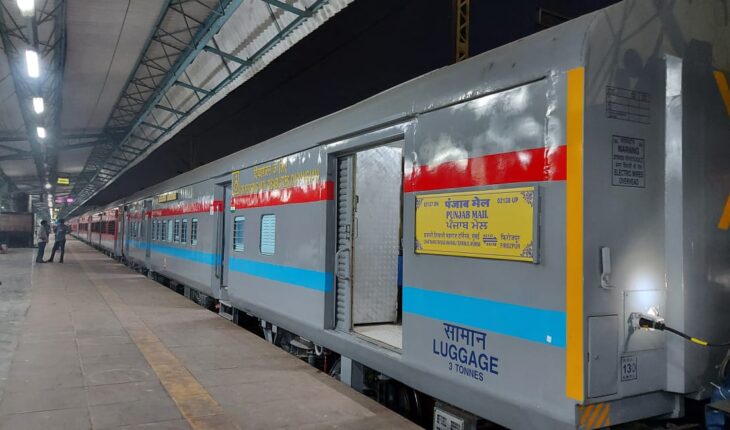By Dominick Rodrigues
Mumbai : If trains could tell their tales about their trails on the rails, then the Punjab Mail would be narrating innumerable lines of its 109-year journey down the railway line beginning from Bombay to Peshawar in Pakistan. The Punjab Mail — the oldest train in the Indian Railways — completed 109 years on June 1.
The India-Pakistan journey was shortened after independence, but the Punjab Mail still continues to chug along its usual route. Despite the Covid-19 lockdown suspending train services from March 22, 2020, reopening witnessed the Punjab Mail special beginning its journey from December 1, 2020 with LHB coaches that provide more safety and pleasant travelling experience to passengers.

While the origins of the Bombay to Peshawar Punjab Mail are rather unclear, a ‘Cost Estimate’ paper circa 1911 and a ‘complaint’ by an irate passenger circa October 12, 1912 about the ‘late arrival of the train by a few minutes at Delhi’ highlights the Punjab Mail making her maiden run out of Ballard Pier Mole station in Mumbai on June 1, 1912.
While the Punjab Mail is over 16 years older than the more glamorous Frontier Mail, the Ballard Pier Mole station was actually a hub for GIPR (Great Indian Peninsular Railway) services. The Punjab Mail — or Punjab Limited as it was then called — finally steamed out on 1 June 1912.
To begin with, there were the P & O steamers bringing in the mail, and the Officers of the Raj, along with their wives, on their first posting in Colonial India. The steamer voyage between Southampton and Bombay lasted thirteen days due to the British officials holding combined tickets — both for their voyage to Bombay, and also inland journey by train to their place of posting – through disembarking and simply boarding one of the trains bound for Madras, Calcutta or Delhi.
The ‘Punjab Limited’ used to run on fixed mail days from Bombay’s Ballard Pier Mole station all the way to Peshawar, via the GIP route, covering the distance of 2,496 km in about 47 hrs. The train comprised of six cars: three for 96 passengers, and three for postal goods and mail. The sparkling cars were all corridor cars, and were made up of first class, dual berth compartments catering to the upper-class gentry with offerings like lavatories, bathrooms, restaurant car and a compartment for: luggage and the servants of the white sahibs.
During the pre-partition period, the Punjab Limited was the ‘fastest train’ in British India with its route crossing the GIP track for the large part, and passing through Itarsi, Agra, Delhi and Lahore, before terminating at Peshawar Cantonment. Originating and terminating at Bombay Victoria Terminus (now Chhatrapati Shivaji Maharaj Terminus) from 1914, the train then loosely came to be known as the Punjab Mail, rather than Punjab Limited, and became a daily service.
From a service meant primarily for the ‘’upper-class white sahibs’, the Punjab Mail soon started catering to the lower classes too and third class cars started appearing on the Punjab Mail by the mid-1930s. In 1914, the GIP route from Bombay to Delhi was some 1,541 km. which the train used to cover in 29 hr. 30 min.
In the early 1920s, this transit time was further reduced to 27 hr. 10 minutes — despite as many as 18 intermediate stops. In 1972, the transit time was again pushed up to 29 hrs and, by 2011, the Punjab Mail had 55 intermediate stops. The Punjab Mail got an air-conditioned car in 1945, and from May 1, 1976, it was run with diesel locomotive.
After electrification of the Thul Ghats, the train has been hauled through electricity from Bombay VT to Manmad – after which the WP class steam engines took over till Firozpur. In 1968, the train was dieselized upto Jhansi, and its loading increased from 12 to 15 cars. Dieselization was later extended from Jhansi till New Delhi, then by 1976, onwards till Firozpur. The number of coaches was increased to 18, with two coaches getting added on at Jhansi. In the late 1970/early 1980s, WCAM/1 dual current locomotive ran the Punjab Mail on electric traction right upto Bhusaval, with the changeover from DC to AC traction at Igatpuri.

Today, the Punjab Mail takes 34 hrs and 15 minutes to cover the 1,930 km between Mumbai and Firozpur Cantonment — using electric engines – while the restaurant car has been replaced by a pantry car. At present, the Punjab Mail Special has one AC First Clas- cum-AC2 Tier, Two AC2 Tier, Six AC3 Tier, 6 Sleeper Class, one pantry car, 5 general second class coaches and one generator van.






